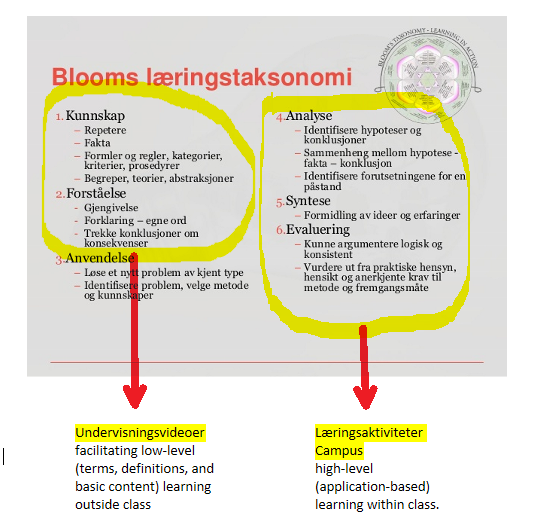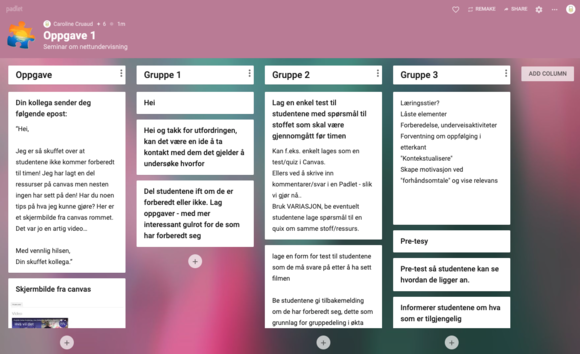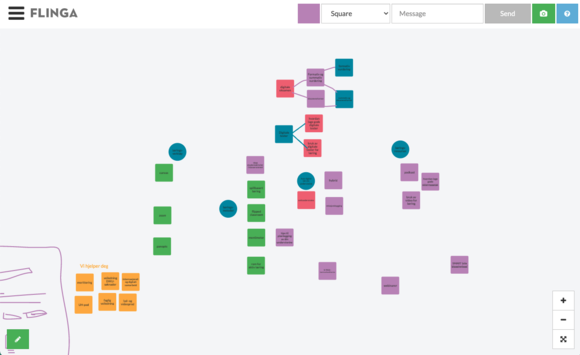
Why should I opt for student active learning approaches?
The report "Quality in Norwegian Higher Education" published in 2015 by the Nordic Institute for Studies in Innovation, Research and Education (NIFU), states that the organisation of teaching and the design of learning activities exert a major influence on how and what students learn, and that there are many ways of organising student learning.
The report emphasises that the following factors can be beneficial to student learning:
- more frequent feedback
- more emphasis on interaction between teachers and their students
- switching between teaching approaches (seminars with space for the exploration of knowledge content, oral presentations, literature reviews, discussion and reflection)
The deliberate use of approaches that activate students in different ways appears to broaden student competencies. Students learn to collaborate and become more motivated. At the same time, it is important to acknowledge that different subjects employ different approaches to knowledge production and the structuring of knowledge content. Your choice of teaching approaches and learning activities should thus reflect the nature of your subject.
What does research have to say about student active learning?
An interesting finding is that even though students learn more effectively when they are active, as opposed to passively attending lectures, they perceive the more passive learning approaches as being more effective. For this reason, we commonly observe a divergence between what students want from their subject assessment and what in fact leads to better performance in their examinations.
The following is a short list of some of the benefits of active learning (Source: Center for teaching innovation, Cornell University):
- greater student attentiveness
- immediate and more frequent feedback to students
- students are given the opportunity to think and talk about, as well as process, their learning content
- students are able to connect to, and acquire a sense of ownership of, their learning content, which boosts their motivation to learn more
- students acquire a sense of belonging in the classroom due to greater student-student and student-teacher interaction
Research also shows that when a student is listening passively to a lecture, attentiveness starts to decline after between 10 and 20 minutes. By introducing short activities into your lectures, you ensure that your students remain attentive.
Working to develop learning activities?
Our students’ learning outcomes form the basis of the learning activities we should be selecting. Let’s assume that a given subject has the following learning outcome at a high taxonomic level: the student can discuss a clinical problem from a scientific theoretical perspective. Is it possible for a lecture, in which the students take down what the teacher is saying, to contribute towards achieving this learning outcome?
The figure below illustrates the methods that should be applied to promote learning at the various taxonomic levels. In general terms, it is true that aids such as teaching videos are best suited to lower taxonomic levels, resulting in what we call superficial learning. Learning outcomes at higher taxonomic levels are characterised by deep learning and meta-learning and are achieved in response to a variety of learning activities taking place online or on campus.

To do list for activity design
The following is a check list of items that should be taken into consideration when you design your learning activities. It is an expanded version of a check list published by the Center for Teaching Innovation at Cornell University):
- Decide whether the learning activity is to be implemented individually, in pairs, in groups, or with the whole class.
- Shall the activity be implemented prior to, during or after a teaching session?
- Consider whether the learning activity should be linked to the learning outcomes?
- Does the learning activity exist in isolation, or is it part of an integrated whole made up of several components?
- How much time is needed to complete the learning activity?
- Make sure that your students understand the aims and objectives of the learning activity(ies). You should explain to your students in general terms the benefits they will obtain from the relevant learning activity(ies).
Think about how you intend to organise the learning activity:
- How are you going to introduce the learning activity?
- Do you need to offer help, guidance or instruction prior to, during or after the activity?
- How will the learning activity be completed/summed-up?
Feel free to introduce an informal ‘ice-breaker’ activity at the beginning of the term/teaching period as a means of preparing your students socially for future learning activities. In this way they will be better prepared psychologically to take an active part. Check out the page ‘Building relations online’ for tips about digital ice breakers.
Examples of activities
There are many things that you can do to activate your students. You will achieve a better foundation for learning when your learning outcomes, learning activities and approaches to student assessment are integrated together (Check out the page ‘Plan your teaching’). However, even modest activities such as games or an ice-breaker will help to create a more secure learning environment for your students.
Are you looking for some inspiration? The following are some examples that you can adapt to suit your needs:
Resources
- Active Learning, Center for teaching innovation, Cornell University.
- Mentimeter for interactive teaching, USN eDU.
- Damşa, Crina et al. (2015). Quality in Norwegian Higher Education, NIFU.

